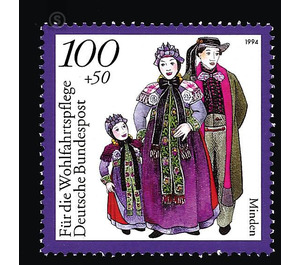welfare: German national costumes - Germany / Federal Republic of Germany 1994 - 100 Pfennig
Theme: Devices, Items & Instruments
| Country | Germany / Federal Republic of Germany |
| Issue Date | 1994 |
| Face Value | 100.00 |
| Color | multi-colored white blue |
| Perforation | K 13 3/4 |
| Printing Type | Multicolor offset printing |
| Stamp Type | Postage stamp |
| Item Type | Stamp |
| Chronological Issue Number | 1632 |
| Chronological Chapter | GER-BRD |
| SID | 503304 |
| In 47 Wishlists | |
The costume, in the sense of the time-related regional typical expression of a rural form of clothing, came in the middle of the 19th century increasingly in the field of vision of the city dwellers. The bourgeois enthusiasm for traditional costumes developed the idea of traditional costumes and their renewal, which led to the founding of organized costumes care in associations. Under this influence, the population in rural areas, where there was no typical regional clothing, now searched for leftovers. Rural costume was often based on fashionable developments and was designed on certain occasions and the different ages according to functionally as work clothes, as festive state, as a communion dress. At mourning and for the wedding one dressed in different way and compilation. In Westphalia, for example, at the end of the 19th century, a set for joy time and one for mourning were distinguished in the high-festive church dress of women. The white parts of the costume were simply kept in mourning, instead of the lace and the rich white embroidery, often unembroidered tulle and batiste. The choice of materials was determined by the conditions of luxury goods production and market supply, which had differed regionally in Central Europe in the 19th century. The bridal crown worn by aristocratic and middle-class brides until the 18th century was still in use in the countryside during the 19th century and beyond, while in many cities the simple myrtle wreath was often used for wedding ceremonies. In Bückeburgischen at the end of the last century, the crown badges of the young girls, they always put on festive occasions and on the wedding day the last time. For the women's costume in Bückeburg since the seventies of the last century, the wing hood was typical. At that time the Sorbian bride wore a high cap of heavy velvet, which was decorated with the bridal wreath on top. The white bridal gown became more and more prevalent among noble brides in the 19th century, while otherwise black fashionable dresses were worn or traditional clothing confined to the area. In Westphalia, for example, where a distinction was made between high-class and Sunday church attire, brides and bridesmaids dressed in high-quality costumes in some regions at the end of the 19th century. In the course of the 19th century costumes have become uncommon in many areas. The expansion of transport routes, the advent of ready-made clothing around 1850 and the low-cost industrial production of fabrics were factors that led to a change in rural clothing habits. Since the time of the French Revolution, especially men had abandoned the old-fashioned dress customs, in place of which a variety of male class costumes, such as Talar and Sutane, acted as a sign of official authority. In many regions, the population did not dress in costume, but oriented the clothing on fashionable costume of the time. But even in areas where some of the population was still traditional, it was possible that others were already fond of fashion at the same time. Residents of Betzingen still wore costumes, as they had already been deposited in the surrounding towns in the sixties of the 19th century, because students of the art academies in Stuttgart and Dusseldorf came to Betzingen until the First World War to paint scenes from rural life there. Betzinger dressed as "traditional" costumes turned out to be models. Although the »Betzinger Malerschule« contributed to the preservation of the traditional regional clothing, the men's costume in Betzingen around 1900 was carried by barely ten percent of the growing population. In the past decades after the Second World War, the last peasant costumes of Central Europe finally died out. The traditional costume has been detached from the original context of use in a regionally differentiated clothing and leads in folklorism own existence. (Text: Edith Luther, Nuremberg)


